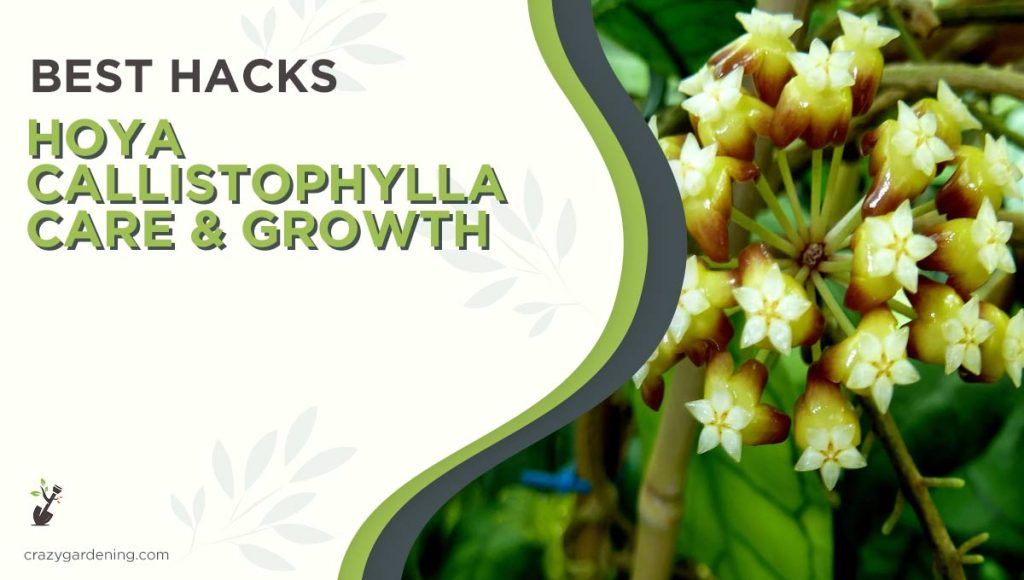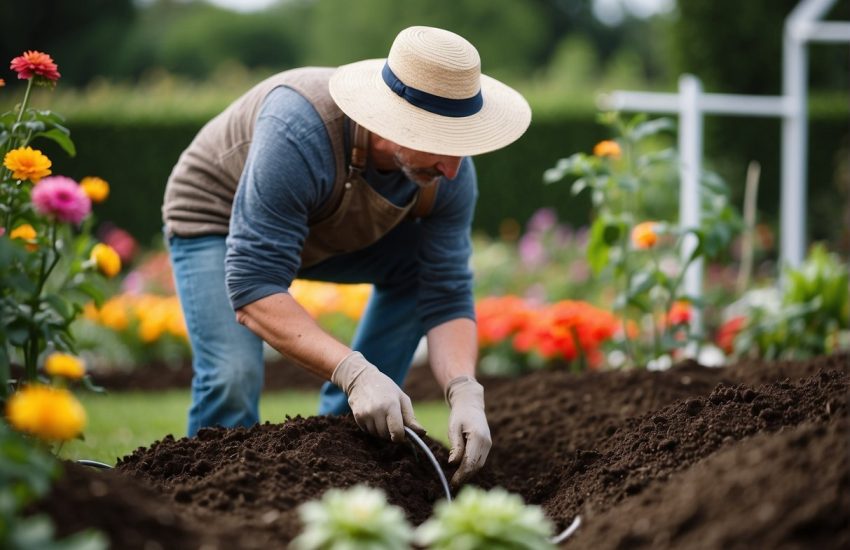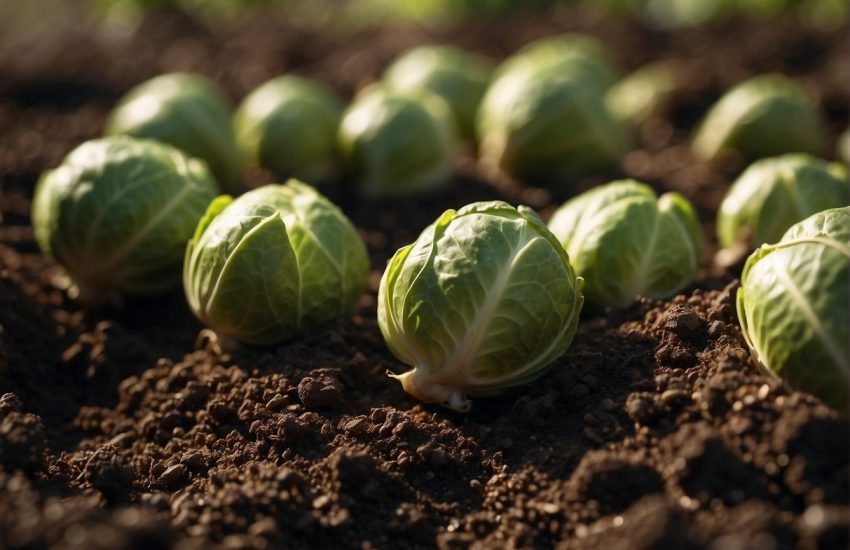Hoya Callistophylla Care [Keep it Happy & Healthy in 2025]
If you want to make your garden beautiful and eye-catching, then you have probably heard of the hoya callistophylla plant. This plant is known for its beautiful, waxy leaves and fragrant flowers.
But did you know that the Hoya callistophylla is also a succulent? This means that it can be grown both indoors and outdoors, making it a perfect addition to any garden or landscape.
In this blog post, we will discuss the care and maintenance of the Hoya callistophylla plant so that you can enjoy its beauty for years to come.
What is Hoya Callistophylla?
Hoyas are commonly referred to as “wax plants” because of their waxy leaves and blooms.
Hoya callistophylla has oval-shaped, bright green leaves that are patterned with dark green nerves. The flowers, however, are the focus of this piece.

The umbrella-shaped flowers are characteristic of the genus Hoya. This plant has white or pale-yellow blossoms with rich crimson borders and a nice scent.
In a greenhouse, the Hoya callistophylla vine can grow to a maximum of 8 feet (2.4 m) in length, while when kept indoors, it can reach a whopping 16 feet (4.9 m).
In a fortunate twist of fate, this evergreen succulent develops slowly. If given the proper attention, it can live for many years and bloom profusely.
Hoya Callistophylla Care and Growth
There are many varieties available in Hoya like Hoya Rotundiflora and more, everyone need different type of care and growth. Let’s examine its salient characteristics and learn how to maintain it properly:
Lighting Requirements
Hoya callistophylla should be grown in bright, indirect sunlight.
If you live in a climate with intense sunlight, it is best to grow this plant under the tree canopy or under filtered light. However, too little light will result in fewer blooms and leggy growth.
Your Hoya callistophylla’s flowering potential is highly sensitive to the amount of light it receives. Make sure your plant gets about 8 hours of indirect sunshine per day during the spring and summer.
Reduce the plant’s light exposure, and you may notice that your Hoya is not flowering at all or later date than usual.
Watering Requirements
As with most succulents, the Hoya callistophylla does not like to be waterlogged. Be sure to plant your hoya in well-draining soil and water only when the topsoil is dry to the touch.
Avoid getting water on the leaves, as this can lead to leaf spots or other diseases. During the winter months, you can cut back on watering even further.
Between waterings, let the soil dry out. If the top 2 inches (5 cm) are dry, soak your Hoya callistophylla.
Splashing the leaves with water can induce fungal problems. Yellowing leaves indicate overwatering or root damage.
Fertilizing Requirements
Since the Hoya callistophylla is a slow-growing plant, it does not require a lot of fertilizer.
A light feeding once a month during the growing season should be sufficient. Be sure to use a balanced fertilizer that is low in nitrogen.
Pruning Requirements
Pruning is only necessary if you want to control the size or shape of your Hoya callistophylla.
To encourage blooming, cut back the stems after the plant has finished flowering. This will also help to keep the plant from becoming too leggy.
Re-potting Requirements
Since the Hoya callistophylla is a slow-growing plant, it does not need to be repotted very often.
Once every two or three years should be sufficient. Be sure to use a pot that is slightly larger than the previous one and has good drainage holes.
Humidity Requirement
This plant prefers high humidity, so misting it regularly will help to keep the leaves healthy and promote blooming.
If you live in a dry climate, you may want to grow your Hoya callistophylla in a terrarium or greenhouse.
If you want to boost the humidity around your Hoya plant, put it on a pebble tray. To boost humidity, place it near other plants or use a humidifier.
Brown spots and fungus can appear on leaves if they are constantly wet. Make sure the leaves are dry before watering the plant again.
Temperature Requirements
The ideal temperature range for the Hoya callistophylla is between 60 and 80 degrees Fahrenheit (15 and 27 degrees Celsius). If the temperature gets too cold, the plant may go into dormancy.
How to Propagate Hoya Callistophylla?
* Stem cuttings are the most effective means of reproducing Hoya Callistophylla. Follow these methods to harvest and root stem cuttings for maximum success:
* Stem cuttings should only be harvested in the spring and summer.
* Cut only the non-woody green parts and use those.
* Cut the stems off at a node with a few leaves and a few inches of length for each cutting.
* Get rid of them by slicing them off 1 in. from where the leaves join the stem (the leaf node should stay on the cutting)
* Plant seeds on soil that is kept slightly damp or in water.
* Water regularly, but don’t let the soil become soaked.
* You should see root growth within a month.
* Hold off on transplanting for another couple of months to allow roots to strengthen.
Growth of Hoya Callistophylla
Despite its evergreen status, the Hoya Callistophylla grows quite quickly for a plant of its type.
However, the environment and care given to it are crucial to its development. It is likely to flourish and develop rapidly under optimal conditions.
With proper maintenance, the Hoya Callistophylla plant has a potential height of 3 to 5 meters (118 to 197 inches).
The plant can either be trained to grow upward with the help of totems or trained to grow downward from a basket, where its vines will trail down. Hoya Callistophylla is a plant that has light green, glossy leaves with dark green venation.
There is an outward tendency in the leaf growth, which can reach a few inches. The length of the petals ranges from 0.4 to 1.2 inches (1 to 3 centimeters), and the diameter of the leaves averages 10 inches (25 centimeters).
Common Problems for Hoya Callistophylla Plants
It is important to be aware of the various problems that your Hoya Callistophylla plant might face so that you can take appropriate measures to address them.
Pests and Diseases
The Hoya callistophylla is relatively resistant to pests and diseases. However, mealybugs can be a problem, particularly if the plant is grown indoors.
These pests are small, white, and fuzzy and tend to congregate on the stems and leaves. They can be controlled with insecticidal soap or neem oil.
Diseases that can affect your Hoya callistophylla include root rot and leaf spot. Root rot is caused by over-watering and results in yellowing leaves, wilting, and eventually death.
Leaf spot is characterized by brown or black spots on the leaves and can be caused by too much water, insufficient light, or fungal infections.
Solution
It is important to take measures to prevent an infestation by these pests, as well as to address an infestation if it does occur.
One way to prevent an infestation is to regularly check your plant for signs of pests and bugs. If you notice any, take steps to remove them immediately.
Botrytis Blight
Another common problem that Hoya Callistophylla plants face is botrytis blight, which is caused by a fungus. This problem is characterized by brown or black spots on the leaves, as well as wilting and yellowing.
Solution
It is important to take measures to prevent botrytis blight, as well as to address it if it does occur.
One way to prevent the fungus from taking hold is to make sure that the leaves are dry before watering the plant. If you notice any signs of the fungus, take steps to remove it immediately.
Root rot
Root rot is another common problem that Hoya Callistophylla plants face. This problem is caused by over-watering and results in yellowing leaves, wilting, and eventually death.
Solution
It is important to take measures to prevent root rot, as well as to address it if it does occur.
One way to prevent root rot is to make sure that the soil is well-draining. If you notice any signs of the problem, take steps to remove the affected roots immediately.
Not flowering
One of the most common problems that Hoya Callistophylla plants face is not flowering. This problem is usually caused by insufficient light, incorrect temperature, or poor nutrition.
Solution
It is important to take measures to prevent the plant from not flowering, as well as to address the problem if it does occur.
* One way to prevent the problem is to make sure that the plant is getting enough light.
* Another way to prevent the problem is to make sure that the temperature is between 60 and 70 degrees Fahrenheit (15 and 21 degrees Celsius).
* Finally, make sure that the plant is getting the nutrients it needs by fertilizing it regularly.
Leaf Discoloration
Another common problem that Hoya Callistophylla plants face is leaf discoloration. This problem is usually caused by insufficient light or incorrect watering.
Solution
It is important to take measures to prevent the plant from leaf discoloration, as well as to address the problem if it does occur. One way to prevent the problem is to make sure that the plant is getting enough light.
Another way to prevent the problem is to make sure that you are watering the plant correctly.
Conclusion
The Hoya callistophylla is a beautiful succulent that is easy to care for and maintain. With proper care, it will bloom profusely and provide you with years of enjoyment.
However, it is important to be aware of the common problems that your plant may face so that you can take appropriate measures to address them.
Root rot, botrytis blight, and not flowering are all common problems that Hoya callistophylla plants may face. With proper care and attention, these problems can be prevented or resolved.
FAQs
Question
Why is my Hoya Callistophylla plant not flowering?
Answer
This problem is usually caused by insufficient light, incorrect temperature, or poor nutrition. It is important to take measures to prevent the plant from not flowering, as well as to address the problem if it does occur. You can avoid the problem is to making sure that the plant is getting enough light.
Question
Do Hoyas like sunlight?
Answer
Planting new Hoya Callistophyllas is a simple process. A healthy Callistophylla plant, some water, sterile gardening tools, and basic preparation are all you need to get started. The outcomes will be much better if you do this in the summer or spring.
Question
Is Hoya callistophylla a slow grower?
Answer
Hoya callistophylla is generally considered to be a slow-growing plant. It is known for its delicate, lacy leaves and delicate, waxy flowers, which can take some time to appear.
Question
Is Hoya callistophylla rare?
Answer
Hoya callistophylla is not considered to be a particularly rare plant. It is a type of Hoya plant, which is a large and diverse group of plants that includes a wide range of species and cultivars. While some Hoya plants are more rare or difficult to find than others, Hoya callistophylla is generally considered to be fairly common and readily available.
Question
How do I make my hoya plant more full?
Answer
>- There are a few steps you can take to help make your hoya plant more full and dense: * Prune regularly to encourage new growth * Provide the plant with plenty of bright, indirect light * Water regularly without overwatering * Fertilize with a balanced fertilizer * Consider repotting the plant into a larger container if needed These steps can help promote healthy growth and encourage your hoya plant to become more full and dense.
Question
Does cutting Hoya encourage growth?
Answer
Yes, in general, pruning hoya plants can help to encourage new growth and keep the plant looking healthy and full. Pruning can help to remove any damaged, diseased, or dead growth, and can also help to promote the development of new shoots and flowers.


